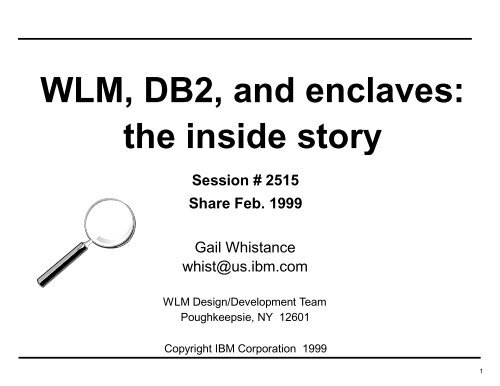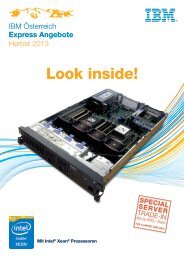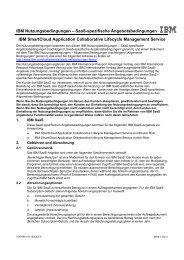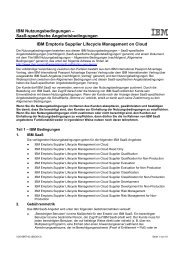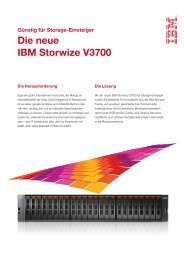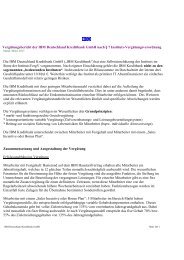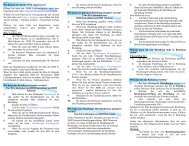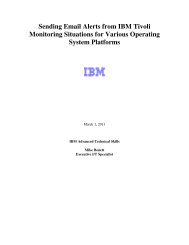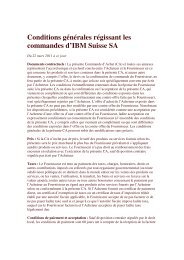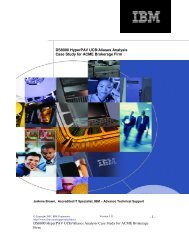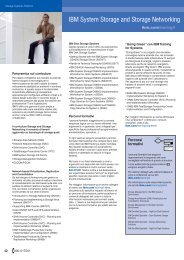WLM, DB2, and enclaves - the inside story - IBM
WLM, DB2, and enclaves - the inside story - IBM
WLM, DB2, and enclaves - the inside story - IBM
You also want an ePaper? Increase the reach of your titles
YUMPU automatically turns print PDFs into web optimized ePapers that Google loves.
<strong>WLM</strong>, <strong>DB2</strong>, <strong>and</strong> <strong>enclaves</strong>:<br />
<strong>the</strong> <strong>inside</strong> <strong>story</strong><br />
Session # 2515<br />
Share Feb. 1999<br />
Gail Whistance<br />
whist@us.ibm.com<br />
<strong>WLM</strong> Design/Development Team<br />
Poughkeepsie, NY 12601<br />
Copyright <strong>IBM</strong> Corporation 1999<br />
1
<strong>WLM</strong>, <strong>DB2</strong>, <strong>and</strong> <strong>enclaves</strong> - <strong>the</strong> <strong>inside</strong> <strong>story</strong><br />
Copyrights <strong>and</strong> Trademarks<br />
(c) Copyright <strong>IBM</strong> Corporation 1999.<br />
Database 2, MVS/ESA, OS/390, <strong>and</strong> RACF are trademarks of <strong>the</strong> International<br />
Business Machines Corporation.<br />
<strong>IBM</strong> <strong>and</strong> <strong>DB2</strong> are registered trademarks of <strong>the</strong> International Business Machines<br />
Corporation.<br />
SHARE Session 2515 (c) copyright <strong>IBM</strong> Corporation 1999 Feb. 1999<br />
2
<strong>WLM</strong>, <strong>DB2</strong>, <strong>and</strong> <strong>enclaves</strong> - <strong>the</strong> <strong>inside</strong> <strong>story</strong><br />
Agenda<br />
What is an enclave anyway?<br />
What problems are being solved?<br />
<strong>DB2</strong> V4 - distributed <strong>DB2</strong> requests (DDF)<br />
<strong>DB2</strong> V5 - sysplex query parallelism<br />
<strong>DB2</strong> V5 - stored SQL procedures<br />
O<strong>the</strong>r workloads using <strong>enclaves</strong><br />
SHARE Session 2515 (c) copyright <strong>IBM</strong> Corporation 1999 Feb. 1999<br />
3
<strong>WLM</strong>, <strong>DB2</strong>, <strong>and</strong> <strong>enclaves</strong> - <strong>the</strong> <strong>inside</strong> <strong>story</strong><br />
What is an enclave?<br />
Represents a "business unit of work"<br />
Is managed separately from <strong>the</strong> address space<br />
Can include multiple SRBs/TCBs<br />
SRBs are preemptible type<br />
Can span multiple address spaces<br />
Can have many <strong>enclaves</strong> in a single address space<br />
Exists in both goal <strong>and</strong> compatability mode<br />
assigned to service class or PGN<br />
managed separately from address space<br />
SHARE Session 2515 (c) copyright <strong>IBM</strong> Corporation 1999 Feb. 1999<br />
4
<strong>WLM</strong>, <strong>DB2</strong>, <strong>and</strong> <strong>enclaves</strong> - <strong>the</strong> <strong>inside</strong> <strong>story</strong><br />
DDF<br />
SHARE Session 2515 (c) copyright <strong>IBM</strong> Corporation 1999 Feb. 1999<br />
5
<strong>WLM</strong>, <strong>DB2</strong>, <strong>and</strong> <strong>enclaves</strong> - <strong>the</strong> <strong>inside</strong> <strong>story</strong><br />
Management of DDF Work<br />
Problem:<br />
Heavy DDF loads can<br />
prevent entry of new<br />
requests<br />
No way to manage DDF<br />
transactions<br />
individually...everything runs<br />
with <strong>the</strong> ssnmDIST address<br />
space's controls<br />
Solution:<br />
Make DDF transactions<br />
visible to SRM as <strong>enclaves</strong><br />
Individually, classified,<br />
managed, <strong>and</strong> reported<br />
Subject to period switch<br />
Work is run under SRBs<br />
that are dispatched like<br />
tasks ra<strong>the</strong>r than like local<br />
SRBs<br />
SHARE Session 2515 (c) copyright <strong>IBM</strong> Corporation 1999 Feb. 1999<br />
6
<strong>WLM</strong>, <strong>DB2</strong>, <strong>and</strong> <strong>enclaves</strong> - <strong>the</strong> <strong>inside</strong> <strong>story</strong><br />
Previous DDF Implementation<br />
ssnmDIST<br />
ssnmDBM1<br />
Local SRB<br />
PC to run SQL<br />
Data/rc returned<br />
Network<br />
Task<br />
SMF 30, 72<br />
CPU time<br />
SHARE Session 2515 (c) copyright <strong>IBM</strong> Corporation 1999 Feb. 1999<br />
7
<strong>WLM</strong>, <strong>DB2</strong>, <strong>and</strong> <strong>enclaves</strong> - <strong>the</strong> <strong>inside</strong> <strong>story</strong><br />
Managing DDF Work in <strong>DB2</strong> V4R1<br />
ssnmDIST<br />
ssnmDBM1<br />
Network Task<br />
Enclave 1<br />
SRB<br />
PC to run query<br />
Rows returned<br />
Enclave 2<br />
SRB<br />
Enc 2<br />
Enc1<br />
DDF SMF 30 CPU<br />
Enclave<br />
SMF 72<br />
CPU time<br />
DDF SMF 72 CPU time<br />
SHARE Session 2515 (c) copyright <strong>IBM</strong> Corporation 1999 Feb. 1999<br />
8
<strong>WLM</strong>, <strong>DB2</strong>, <strong>and</strong> <strong>enclaves</strong> - <strong>the</strong> <strong>inside</strong> <strong>story</strong><br />
Enclave Accounting<br />
Each enclave represents an individual SRM transaction<br />
Transaction counts <strong>and</strong> resource usage are recorded in <strong>the</strong><br />
SMF 72 record for <strong>the</strong> enclave's service class <strong>and</strong> report class<br />
No SMF 30 records for <strong>enclaves</strong> <strong>the</strong>mselves. Transaction<br />
counts <strong>and</strong> resource usage are recorded in <strong>the</strong> SMF 30 of <strong>the</strong><br />
owning address space.<br />
CPU time consumed by <strong>enclaves</strong> is recorded in <strong>the</strong> SMF 89<br />
records of home address space for usage-based pricing.<br />
SRBs scheduled to an enclave are preemptible, like tasks.<br />
SHARE Session 2515 (c) copyright <strong>IBM</strong> Corporation 1999 Feb. 1999<br />
9
Each enclave represents an individual SRM transaction. An enclave<br />
transaction is assigned to a service class or pgn, <strong>and</strong> its resource usage<br />
<strong>and</strong> execution delays are tracked separately from <strong>the</strong> address spaces<br />
where it runs.<br />
Enclave transaction counts <strong>and</strong> resource usage are recorded in <strong>the</strong> SMF<br />
72 record for <strong>the</strong> enclave's service class/pgn <strong>and</strong> report class/rpgn for<br />
installation accounting <strong>and</strong> chargeback. In addition, <strong>the</strong> resource using <strong>and</strong><br />
delay data for <strong>enclaves</strong> is reported with <strong>the</strong> service/report class of <strong>the</strong><br />
enclave, not with <strong>the</strong> service/report class of <strong>the</strong> address space where it<br />
runs.<br />
Enclave transaction counts <strong>and</strong> resource usage are recorded in <strong>the</strong> SMF<br />
30 records for <strong>the</strong> address space which created <strong>the</strong> enclave (<strong>the</strong> owner<br />
address space). There are no separate SMF 30 records for <strong>enclaves</strong>.<br />
CPU time consumed by <strong>enclaves</strong> is recorded in <strong>the</strong> SMF 89 records of<br />
each home address space in which an enclave SRB runs (<strong>the</strong> participating<br />
address space(s)) for usage-based pricing but is not included in <strong>the</strong> SMF<br />
30 or 72 records for those address space(s).<br />
Because SRBs scheduled to an enclave are preemptible, like tasks, <strong>the</strong>ir<br />
CPU time is counted as CPU service, not SRB service.<br />
10
<strong>WLM</strong>, <strong>DB2</strong>, <strong>and</strong> <strong>enclaves</strong> - <strong>the</strong> <strong>inside</strong> <strong>story</strong><br />
Classifying DDF Transactions<br />
All <strong>enclaves</strong>, including DDF transactions, are classified using<br />
<strong>the</strong> active MVS <strong>WLM</strong> policy in both compatibility <strong>and</strong> goal<br />
modes<br />
In compat mode <strong>the</strong> ICS can be used to map a service class to<br />
a performance group, <strong>and</strong> likewise for reporting<br />
Can classify using new attributes: plan, package, etc.<br />
Defaults if you do not classify in <strong>WLM</strong> policy:<br />
Goal mode: <strong>enclaves</strong> default to <strong>the</strong> SYSOTHER service<br />
class which has a discretionary goal!<br />
Compat mode: any <strong>enclaves</strong> run in <strong>the</strong> pgn/rpgn of <strong>the</strong><br />
owning address space (DDF) as <strong>the</strong>y did before<br />
SHARE Session 2515 (c) copyright <strong>IBM</strong> Corporation 1999 Feb. 1999<br />
11
You do not have to be in a multisystem sysplex or running in <strong>WLM</strong> goal mode to<br />
exploit transaction management via DDF <strong>enclaves</strong>. <strong>DB2</strong> V4 DDF always creates<br />
<strong>enclaves</strong> for its work when running on MVS 5.2.0 or above, or on OS/390.<br />
To classify DDF <strong>enclaves</strong> you must do all of <strong>the</strong> following:<br />
1. Format a MVS Workload Manager couple dataset.<br />
2. Use <strong>the</strong> <strong>WLM</strong> administrative application to create a service definition with<br />
classification rules for subsystem type DDF, <strong>and</strong> at least one service class.<br />
The goal of <strong>the</strong> service class(es) is irrelevant if you are running in <strong>WLM</strong><br />
compatibility mode, that is using parmlib members IEAIPSxx <strong>and</strong> IEAICSxx<br />
to manage work.<br />
3. Install <strong>the</strong> service definition on <strong>the</strong> <strong>WLM</strong> couple dataset <strong>and</strong> activate a policy.<br />
4. If you are running in <strong>WLM</strong> compatibility mode, you must also update <strong>the</strong><br />
IEAICSxx parmlib member by adding rules for subsystem DDF:<br />
SUBSYS=DDF, /* a pgn here is ignored if coded */<br />
SRVCLASS=x,PGN=y,RPGN=z /* "x" is <strong>the</strong> service class assigned in<br />
<strong>the</strong> <strong>WLM</strong> classification rules */<br />
12
<strong>WLM</strong>, <strong>DB2</strong>, <strong>and</strong> <strong>enclaves</strong> - <strong>the</strong> <strong>inside</strong> <strong>story</strong><br />
Managing DDF Work (Enclaves)<br />
Transactions are subject to period switch<br />
Goal mode:<br />
All goal types allowed<br />
Compat mode:<br />
Performance groups <strong>and</strong> report performance groups can be<br />
assigned using SUBSYS=DDF<br />
Limit of one rpgn<br />
Time slicing is ignored<br />
Domain is ignored<br />
SHARE Session 2515 (c) copyright <strong>IBM</strong> Corporation 1999 Feb. 1999<br />
13
<strong>WLM</strong>, <strong>DB2</strong>, <strong>and</strong> <strong>enclaves</strong> - <strong>the</strong> <strong>inside</strong> <strong>story</strong><br />
What is a Transaction?<br />
DRDA request 1 DRDA request 2<br />
Queue time<br />
Execution time<br />
Idle<br />
Queue time<br />
Execution time<br />
hreads =<br />
nactive<br />
Active<br />
Inactive<br />
Active<br />
Inactive<br />
Enclave transaction<br />
managed by SRM<br />
Enclave transaction<br />
managed by SRM<br />
hreads =<br />
Active<br />
Database thread is active from creation until termination<br />
Enclave transaction managed by SRM exhibits conversational behavior<br />
SHARE Session 2515 (c) copyright <strong>IBM</strong> Corporation 1999 Feb. 1999<br />
14
<strong>WLM</strong>, <strong>DB2</strong>, <strong>and</strong> <strong>enclaves</strong> - <strong>the</strong> <strong>inside</strong> <strong>story</strong><br />
What Goals Should I Use?<br />
<strong>WLM</strong> compatibility mode<br />
Goal does not matter. Service class used only to associate<br />
an enclave with a performance group.<br />
<strong>WLM</strong> goal mode<br />
THREADS=INACTIVE <strong>and</strong> RELEASE(COMMIT)<br />
DDF creates one enclave per active interval<br />
Response times do not include think time<br />
Response time goals <strong>and</strong> multiple periods can be used<br />
THREADS=ACTIVE or RELEASE(DEALLOCATE)<br />
DDF creates one enclave for <strong>the</strong> life of <strong>the</strong> thread<br />
Enclave response time includes think time<br />
Response time goals should not be used<br />
Multiple periods should not be used<br />
SHARE Session 2515 (c) copyright <strong>IBM</strong> Corporation 1999 Feb. 1999<br />
15
<strong>WLM</strong>, <strong>DB2</strong>, <strong>and</strong> <strong>enclaves</strong> - <strong>the</strong> <strong>inside</strong> <strong>story</strong><br />
Definition of CPU Service has Changed<br />
Philosophical refinement<br />
Compatible with <strong>the</strong> existing definition<br />
CPU time/service are no longer synonymous with "task<br />
time/service"<br />
CPU time/service now includes contributions from all<br />
preemptible dispatchable units: tasks, client SRBs, enclave<br />
SRBs<br />
SRB time/service is unchanged - it includes contributions from<br />
all non-preemptible dispatchable units: local <strong>and</strong> global SRBs<br />
SHARE Session 2515 (c) copyright <strong>IBM</strong> Corporation 1999 Feb. 1999<br />
16
<strong>WLM</strong>, <strong>DB2</strong>, <strong>and</strong> <strong>enclaves</strong> - <strong>the</strong> <strong>inside</strong> <strong>story</strong><br />
SMF Type 30 Record Changes<br />
No changes are required to existing accounting packages<br />
Existing CPU time <strong>and</strong> service fields include enclave SRB<br />
contributions<br />
For all <strong>enclaves</strong> created by <strong>the</strong> address space, new fields<br />
contain:<br />
enclave active time<br />
transaction count<br />
CPU time <strong>and</strong> service<br />
I/O times <strong>and</strong> I/O count<br />
SHARE Session 2515 (c) copyright <strong>IBM</strong> Corporation 1999 Feb. 1999<br />
17
<strong>WLM</strong>, <strong>DB2</strong>, <strong>and</strong> <strong>enclaves</strong> - <strong>the</strong> <strong>inside</strong> <strong>story</strong><br />
SMF Type 72 Record Changes<br />
No changes are required to existing accounting packages<br />
Existing CPU service fields include enclave SRB contributions<br />
O<strong>the</strong>r existing fields include data from enclave transactions:<br />
Active time<br />
Response time<br />
Transaction count<br />
Number of "address spaces" sampled<br />
I/O times <strong>and</strong> I/O count<br />
Resources consumed by <strong>the</strong> DDF transactions are no longer<br />
reported in <strong>the</strong> DDF address space's SMF 72 record unless <strong>the</strong><br />
<strong>enclaves</strong> are in <strong>the</strong> same service class/pgn as DDF<br />
SHARE Session 2515 (c) copyright <strong>IBM</strong> Corporation 1999 Feb. 1999<br />
18
<strong>WLM</strong>, <strong>DB2</strong>, <strong>and</strong> <strong>enclaves</strong> - <strong>the</strong> <strong>inside</strong> <strong>story</strong><br />
Enclave System Effects (DDF)<br />
(Lots) more transactions. Each DDF transaction used to be<br />
part of <strong>the</strong> DDF address space SRM transaction, now SRM<br />
sees each DDF transaction.<br />
Increased active time since more transactions exist<br />
Large decrease in DDF SRB time/service in SMF 30 record<br />
Corresponding increase in CPU time/service in <strong>the</strong> service<br />
classes/performance groups where <strong>enclaves</strong> are running<br />
MSO <strong>and</strong> I/O service is unchanged<br />
DDF logons are not held up by existing DDF work<br />
SHARE Session 2515 (c) copyright <strong>IBM</strong> Corporation 1999 Feb. 1999<br />
19
<strong>WLM</strong>, <strong>DB2</strong>, <strong>and</strong> <strong>enclaves</strong> - <strong>the</strong> <strong>inside</strong> <strong>story</strong><br />
Sysplex Query Parallelism<br />
SHARE Session 2515 (c) copyright <strong>IBM</strong> Corporation 1999 Feb. 1999<br />
20
<strong>WLM</strong>, <strong>DB2</strong>, <strong>and</strong> <strong>enclaves</strong> - <strong>the</strong> <strong>inside</strong> <strong>story</strong><br />
Sysplex Query Parallelism<br />
Supports data mining applications<br />
<strong>DB2</strong> query can be split across parallel sysplex<br />
Requires <strong>DB2</strong> V5.1 <strong>and</strong> <strong>DB2</strong> data sharing<br />
Classification of originator doesn't change<br />
Classification of participants is under '<strong>DB2</strong>' rules<br />
Classification attributes inherited from originator<br />
Accounting is done on <strong>the</strong> system where enclave runs<br />
Each remote piece starts in 1st period<br />
SHARE Session 2515 (c) copyright <strong>IBM</strong> Corporation 1999 Feb. 1999<br />
21
<strong>WLM</strong>, <strong>DB2</strong>, <strong>and</strong> <strong>enclaves</strong> - <strong>the</strong> <strong>inside</strong> <strong>story</strong><br />
<strong>DB2</strong> Stored Procedures<br />
SHARE Session 2515 (c) copyright <strong>IBM</strong> Corporation 1999 Feb. 1999<br />
22
<strong>WLM</strong>, <strong>DB2</strong>, <strong>and</strong> <strong>enclaves</strong> - <strong>the</strong> <strong>inside</strong> <strong>story</strong><br />
What is a stored procedure?<br />
MVS<br />
client<br />
EXEC SQL<br />
CALL PROCX<br />
<strong>DB2</strong><br />
schedule PROCX<br />
perform SQL<br />
perform SQL<br />
perform SQL<br />
return data<br />
<strong>DB2</strong> Stored Procedures<br />
Address Space<br />
EXEC SQL<br />
SELECT . . .<br />
EXEC SQL<br />
UPDATE . . .<br />
EXEC SQL<br />
INSERT . . .<br />
proc end<br />
SHARE Session 2515 (c) copyright <strong>IBM</strong> Corporation 1999 Feb. 1999<br />
23
<strong>WLM</strong>, <strong>DB2</strong>, <strong>and</strong> <strong>enclaves</strong> - <strong>the</strong> <strong>inside</strong> <strong>story</strong><br />
Why Use Stored Procedures?<br />
Reduce network send/receive operations for distributed<br />
applications<br />
Reduce elapsed time<br />
Encapsulate business logic <strong>and</strong> database design at <strong>the</strong> server<br />
Protect sensitive data<br />
Eliminate need for end user <strong>DB2</strong> table authority<br />
Simplify management of application programs<br />
Perform online change without impacting clients<br />
Reduce cost of porting client code to o<strong>the</strong>r platforms<br />
SHARE Session 2515 (c) copyright <strong>IBM</strong> Corporation 1999 Feb. 1999<br />
24
<strong>WLM</strong>, <strong>DB2</strong>, <strong>and</strong> <strong>enclaves</strong> - <strong>the</strong> <strong>inside</strong> <strong>story</strong><br />
Limitations in <strong>DB2</strong> V4R1<br />
All stored procedures execute in 1 address space<br />
Multiple procedures can execute concurrently<br />
(NUMTCB parameter in ssnSPAS JCL procedure)<br />
Number of tasks limited by storage constraints below 16M<br />
A programming error in one stored procedure might affect<br />
o<strong>the</strong>r procedures running at <strong>the</strong> same time<br />
All stored procedure requests are treated equally<br />
Queued FIFO<br />
Executed at dispatch priority of ssnSPAS address space<br />
From an MVS perspective, CPU time is charged to <strong>the</strong><br />
ssnSPAS address space<br />
RACF userid of ssnSPAS address space is used for access to<br />
non-SQL resources<br />
SHARE Session 2515 (c) copyright <strong>IBM</strong> Corporation 1999 Feb. 1999<br />
25
<strong>WLM</strong>, <strong>DB2</strong>, <strong>and</strong> <strong>enclaves</strong> - <strong>the</strong> <strong>inside</strong> <strong>story</strong><br />
Stored Procedures in <strong>DB2</strong> V5R1 <strong>and</strong> OS/390 R3<br />
<strong>WLM</strong> work Queue<br />
Application XYZ<br />
SQL work<br />
<strong>DB2</strong> Subsystem<br />
<strong>DB2</strong> Stored Procedures<br />
Process "CALL"<br />
Enclave<br />
Application ABC<br />
<strong>DB2</strong> Stored Procedures<br />
Enclaves<br />
Address space management in goal mode<br />
SHARE Session 2515 (c) copyright <strong>IBM</strong> Corporation 1999 Feb. 1999<br />
26
<strong>WLM</strong>, <strong>DB2</strong>, <strong>and</strong> <strong>enclaves</strong> - <strong>the</strong> <strong>inside</strong> <strong>story</strong><br />
Code <strong>the</strong> stored procedure<br />
Preparation<br />
Bind <strong>the</strong> stored procedure to a package<br />
Code <strong>the</strong> application to call <strong>the</strong> stored procedure<br />
Grant authorization to execute <strong>the</strong> stored procedure<br />
to <strong>the</strong> application<br />
SHARE Session 2515 (c) copyright <strong>IBM</strong> Corporation 1999 Feb. 1999<br />
27
<strong>WLM</strong>, <strong>DB2</strong>, <strong>and</strong> <strong>enclaves</strong> - <strong>the</strong> <strong>inside</strong> <strong>story</strong><br />
Definition<br />
Create a JCL procedure for <strong>the</strong> stored procedure address<br />
space<br />
Define an application environment to <strong>WLM</strong><br />
Authorize <strong>the</strong> stored procedure address space to connect to<br />
<strong>DB2</strong> <strong>and</strong> <strong>WLM</strong><br />
Define <strong>the</strong> stored procedures to <strong>DB2</strong><br />
SHARE Session 2515 (c) copyright <strong>IBM</strong> Corporation 1999 Feb. 1999<br />
28
<strong>WLM</strong>, <strong>DB2</strong>, <strong>and</strong> <strong>enclaves</strong> - <strong>the</strong> <strong>inside</strong> <strong>story</strong><br />
Accounting<br />
Where is service for stored procedures accumulated?<br />
For DDF work<br />
CPU service is included in <strong>the</strong> SMF 30 record for <strong>the</strong> DDF<br />
address space, <strong>and</strong> <strong>the</strong> SMF 72 record for <strong>the</strong> enclave's<br />
service class period<br />
For all o<strong>the</strong>r work<br />
CPU <strong>and</strong> MSO service is included in <strong>the</strong> SMF 30 record of<br />
<strong>the</strong> client's address space, <strong>and</strong> <strong>the</strong> SMF 72 record for <strong>the</strong><br />
client's service class period<br />
IOC <strong>and</strong> SRB service is included in <strong>the</strong> SMF 30 <strong>and</strong> 72 records<br />
for <strong>the</strong> stored procedure address space<br />
SHARE Session 2515 (c) copyright <strong>IBM</strong> Corporation 1999 Feb. 1999<br />
29
<strong>WLM</strong>, <strong>DB2</strong>, <strong>and</strong> <strong>enclaves</strong> - <strong>the</strong> <strong>inside</strong> <strong>story</strong><br />
Stored Procedures Summary<br />
Use stored procedures to improve <strong>the</strong> response time of<br />
distributed applications, <strong>and</strong> to encapsulate data management<br />
logic at <strong>the</strong> server<br />
Use <strong>WLM</strong> to<br />
manage <strong>the</strong> number of stored procedure address spaces to<br />
meet clients' goals<br />
run stored procedures with controls appropriate to clients'<br />
goals<br />
Use application environments to group related stored<br />
procedures<br />
SHARE Session 2515 (c) copyright <strong>IBM</strong> Corporation 1999 Feb. 1999<br />
30
<strong>WLM</strong>, <strong>DB2</strong>, <strong>and</strong> <strong>enclaves</strong> - <strong>the</strong> <strong>inside</strong> <strong>story</strong><br />
Complex transactions <strong>and</strong> <strong>enclaves</strong><br />
VTAM<br />
or<br />
TCP/IP<br />
<strong>DB2</strong> (DDF)<br />
<strong>DB2</strong> (MSTR)<br />
SRB<br />
SRB<br />
* SINGLE REPORTED TRANSACTION<br />
* MULTIPLE DISPATCHABLE UNITS<br />
Enclave<br />
* MIXTURE OF TCB AND SRB<br />
* NO ADDRESS SPACE BOUNDARIES<br />
* SINGLE <strong>WLM</strong> GOAL AND MANAGEMENT ACTIONS<br />
<strong>WLM</strong><br />
SHARE Session 2515 (c) copyright <strong>IBM</strong> Corporation 1999 Feb. 1999<br />
31
<strong>WLM</strong>, <strong>DB2</strong>, <strong>and</strong> <strong>enclaves</strong> - <strong>the</strong> <strong>inside</strong> <strong>story</strong><br />
Putting <strong>the</strong> Pieces Toge<strong>the</strong>r<br />
<strong>DB2</strong> gives you:<br />
V4R1: DDF exploitation of <strong>enclaves</strong><br />
V5R1: Sysplex query parallelism<br />
V5R1: Stored SQL procedures<br />
MVS gives you:<br />
MVS 5.2: Refined definition of CPU time <strong>and</strong> service<br />
MVS 5.2: SRM transactions: <strong>enclaves</strong><br />
OS/390 R3: TCBs in <strong>enclaves</strong>, server management<br />
Toge<strong>the</strong>r <strong>the</strong>se can improve <strong>the</strong> response time <strong>and</strong> systems<br />
management of <strong>DB2</strong> work.<br />
SHARE Session 2515 (c) copyright <strong>IBM</strong> Corporation 1999 Feb. 1999<br />
32
<strong>WLM</strong>, <strong>DB2</strong>, <strong>and</strong> <strong>enclaves</strong> - <strong>the</strong> <strong>inside</strong> <strong>story</strong><br />
Who else uses <strong>enclaves</strong>?<br />
SHARE Session 2515 (c) copyright <strong>IBM</strong> Corporation 1999 Feb. 1999<br />
33
<strong>WLM</strong>, <strong>DB2</strong>, <strong>and</strong> <strong>enclaves</strong> - <strong>the</strong> <strong>inside</strong> <strong>story</strong><br />
O<strong>the</strong>r workloads using <strong>enclaves</strong> include:<br />
Websphere http Server for OS/390 (IWEB)<br />
LAN Server for MVS (LSFM)<br />
Component Broker (CB)<br />
MQ/Series Workflow<br />
. . . (expect more)<br />
In goal mode, make sure you classify <strong>the</strong>m...<br />
default is SYSOTHER.<br />
Keep SYSOTHER empty so it can be used<br />
as warning signal.<br />
SHARE Session 2515 (c) copyright <strong>IBM</strong> Corporation 1999 Feb. 1999<br />
34
<strong>WLM</strong>, <strong>DB2</strong>, <strong>and</strong> <strong>enclaves</strong> - <strong>the</strong> <strong>inside</strong> <strong>story</strong><br />
Hot tips<br />
Don't forget to classify.<br />
Keep work out of SYSOTHER service class.<br />
Know how your DDF transactions are defined.<br />
Check out <strong>WLM</strong> home page.<br />
If new to goal mode, start with Cheryl Watson's Quick<br />
Start Policy.<br />
Select initial goals from peak periods in compat<br />
mode.<br />
When adding new workloads, classify <strong>the</strong>m.<br />
SHARE Session 2515 (c) copyright <strong>IBM</strong> Corporation 1999 Feb. 1999<br />
35
<strong>WLM</strong>, <strong>DB2</strong>, <strong>and</strong> <strong>enclaves</strong> - <strong>the</strong> <strong>inside</strong> <strong>story</strong><br />
Summary<br />
Enclaves enable full <strong>WLM</strong> control<br />
<strong>DB2</strong> is a premier user of <strong>enclaves</strong><br />
Expect o<strong>the</strong>r workloads to use <strong>enclaves</strong> in future<br />
Often used in conjunction with sysplex routing <strong>and</strong><br />
server space management<br />
Enclaves streng<strong>the</strong>n S/390's industry-leading<br />
workload management<br />
SHARE Session 2515 (c) copyright <strong>IBM</strong> Corporation 1999 Feb. 1999<br />
36
<strong>WLM</strong>, <strong>DB2</strong>, <strong>and</strong> <strong>enclaves</strong> - <strong>the</strong> <strong>inside</strong> <strong>story</strong><br />
<strong>IBM</strong> Education Courses<br />
H3995 Parallel Sysplex Implementation (45 minutes on <strong>WLM</strong>)<br />
H4013 Workload Manager Workshop<br />
H3986 Migration<br />
H3988 Measurement <strong>and</strong> Tuning - compatibility to goal mode migration<br />
H3989 Migration<br />
ES540 OS/390 Workload-Based Performance Management (new!)<br />
(check http://www.training.ibm.com around 4/1/99)<br />
MVS Planning: Workload Management (GC28-1761) -- a must have.<br />
MVS Programming: Workload Management Services (GC28-1773)<br />
Chapter on Enclaves including a chart showing how accounting is done.<br />
Chapter on Queueing Manager Services shows <strong>DB2</strong> model<br />
<strong>DB2</strong> for OS/390 V5 Administration Guide (SC26-8957) -- <strong>DB2</strong> use of <strong>enclaves</strong><br />
<strong>WLM</strong> home page: http://www.ibm.com/s390/wlm<br />
For latest papers, presentations, <strong>and</strong> frequently asked questions<br />
SHARE Session 2515 (c) copyright <strong>IBM</strong> Corporation 1999 Feb. 1999<br />
37


